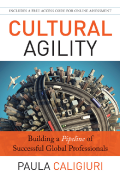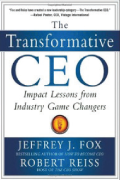TD Magazine Article
Developing Global Savvy
A review of Cultural Agility: Building a Pipeline of Successful Global Professionals by Paula Caligiuri
Thu Nov 08 2012
Cultural Agility: Building a Pipeline of Successful Global Professionals

By Paula Caligiuri
(Jossey-Bass, $36.95, 272 pp.)
Today's increasingly global workplace requires new workforce competencies. Cultural intelligence, cultural awareness, and intercultural communication are hot topics in the employee development space. In her book, Cultural Agility: Building a Pipeline of Successful Global Professionals, Paula Caligiuri describes how to leverage such skills to create culturally agile human capital.
Caligiuri says cultural agility is the "mega-competency that enables professionals to perform successfully in cross-cultural situations." She outlines 12 key competencies that comprise the cultural agility framework: cultural minimization, cultural adaptation, and cultural integration affect behavioral responses; tolerance of ambiguity, appropriate self-efficacy, and cultural curiosity affect cross-cultural psychological ease; valuing diversity, ability to form relationships, and perspective-taking affect cross-cultural interactions; and knowledge and integration of cross-cultural issues, receptivity to adopting diverse ideas, and divergent thinking and creativity affect cross-cultural decisions.
After detailing each of these competencies, Caligiuri shares how readers can attract, recruit, assess, select, train, and develop culturally agile employees. Essentially, she offers an integrated talent management approach to building a pipeline of successful global professionals.
As a starting point, Caligiuri recommends readers look for talent at universities that boast culturally rich study abroad programs, within international and cross-cultural organizations, and through multicultural social media networking groups. She provides practical strategies that organizations can implement to build a better global image, and thereby attract more culturally agile talent. The book also includes résumé screenings, assessment tools, and interview techniques to help employers identify key competencies among prospective employees.
As far as workplace learning and development, Caligiuri notes: "A learning system to develop cultural agility needs to include two parts, cross-cultural training and experiential development opportunities." Training goals include building a framework for how cultures differ, gaining culture-specific knowledge, learning methods for cross-cultural discovery, and understanding the cross-cultural adjustment process.
Developmental experiences—such as mentoring programs, global project teams, and international volunteerism programs—also are necessary for competency mastery. To be most effective, such experiences should allow employees to engage in meaningful interactions with peer-level colleagues from different cultures; use their knowledge, skills, and abilities in different cultural contexts; and receive feedback on their performance in roles requiring cultural agility.
This book is packed with real-life examples of companies that have mastered the key competencies, practical action steps listed at the conclusion of each chapter, and tools readers can use today to begin building a culturally agile talent pipeline. Timely and leading-edge, engaging and practical, Cultural Agility is a must-read for any organization seeking to succeed in today's global economy. Four cups!
Contented Cows Still Give Better Milk: The Plain Truth about Employee Engagement and Your Bottom Line

Bill Catlette and Richard Hadden
(Wiley, $24.95, 208 pp.)
This book is a revised and expanded edition of the original, Contented Cows Give Better Milk, which makes the case that treating employees right is always the best thing any corporation can do for its bottom line. Catlette and Hadden offer new examples of organizations and updated case studies to further confirm that happy employees are vital to every business. Contented Cows Still Give Better Milk offers many takeaways, including why perks, benefits, and amenities don't tell the whole story of what makes a great workplace, and how to hire and retain people with the capacity to be happy, productive, and successful at your organization.
The Transformative CEO: Impact Lessons from Industry Game Changers

Jeffrey J. Fox and Robert Reiss
(McGraw-Hill, $22, 256 pp.)
As a manager, enacting change can be a grueling task, but Duncan has set out to make it a friendlier, stress-free process. He offers a roadmap for change by outlining seven steps to guide readers through the journey. These steps are validate the journey, scan for speed bumps, chart the course, build a coalition, ford the streams, stay on message, and mind the gap. Duncan writes invaluable insight for those leading an organization through the murky waters of change. For example, "in addition to making a solid business case for change, you must make a compelling psychological case for change." The book provides a pathway for keeping change as beneficial—and enjoyable—as possible.
The Basics of Project Evaluation and Lessons Learned

Willis H. Thomas
(Productivity Press, $19.95, 161 pp.)
The Basics of Project Evaluation and Lessons Learned is an easy-to-understand guide to evaluating one's projects and the resulting lessons learned. Thomas gives readers the tools to examine the impact of projects, evaluate knowledge learned from past projects, and determine if a project actually was a success. This book combines many best practices in an easy-to-follow process and incorporates the five project management groups—initiating, planning, executing, monitoring/controlling, and closing. It is ideal for anyone managing a project, from a small program in a not-for-profit organization to a large venture in a multinational corporation.
What's on Harold Stolovitch's Bookshelf?

Human Competence: Engineering Worthy Performance by Thomas F. Gilbert. Gilbert's brilliant understanding of how humans learn and perform is lucidly articulated in this classic volume about human effort, behavior, and accomplishment. It is the foundational document for the field of human performance technology and clearly defines human competence in "a precise and unambiguous way."
Synaptic Self: How Our Brains Become Who We Are and The Emotional Brain: The Mysterious Underpinnings of Emotional Life by Joseph LeDoux. These two volumes provide an entry lesson about the brain, helping us to understand who and what we are as a result of its composition and functioning. In Synaptic Self, LeDoux admits that neuroscience has only just begun to explore the intricate labyrinth we call the brain. Nevertheless, "many pieces of the puzzle have already been discovered and just have to be assembled into a coherent whole," which is what he does for us. The Emotional Brain takes us into the largely unexplored territory of human emotion, sharing what has been learned about the powerful impact our emotional systems have on how we treat and react to information we receive.
Hard Facts, Dangerous Half-Truths, and Total Nonsense: Profiting from Evidence-Based Management by Jeffrey Pfeffer and Robert I. Sutton. The authors present the effects of poor management decision making on organizational success and failure. They demonstrate how personal ideologies, hubris, unsubstantiated beliefs, traditions, and lore often trump data and evidence in leadership judgments and actions. This book has strongly influenced my work with organizations—I often make it a must-read for my clients and students.
You've Reached ATD Member-only Content
Become an ATD member to continue
Already a member?Sign In
